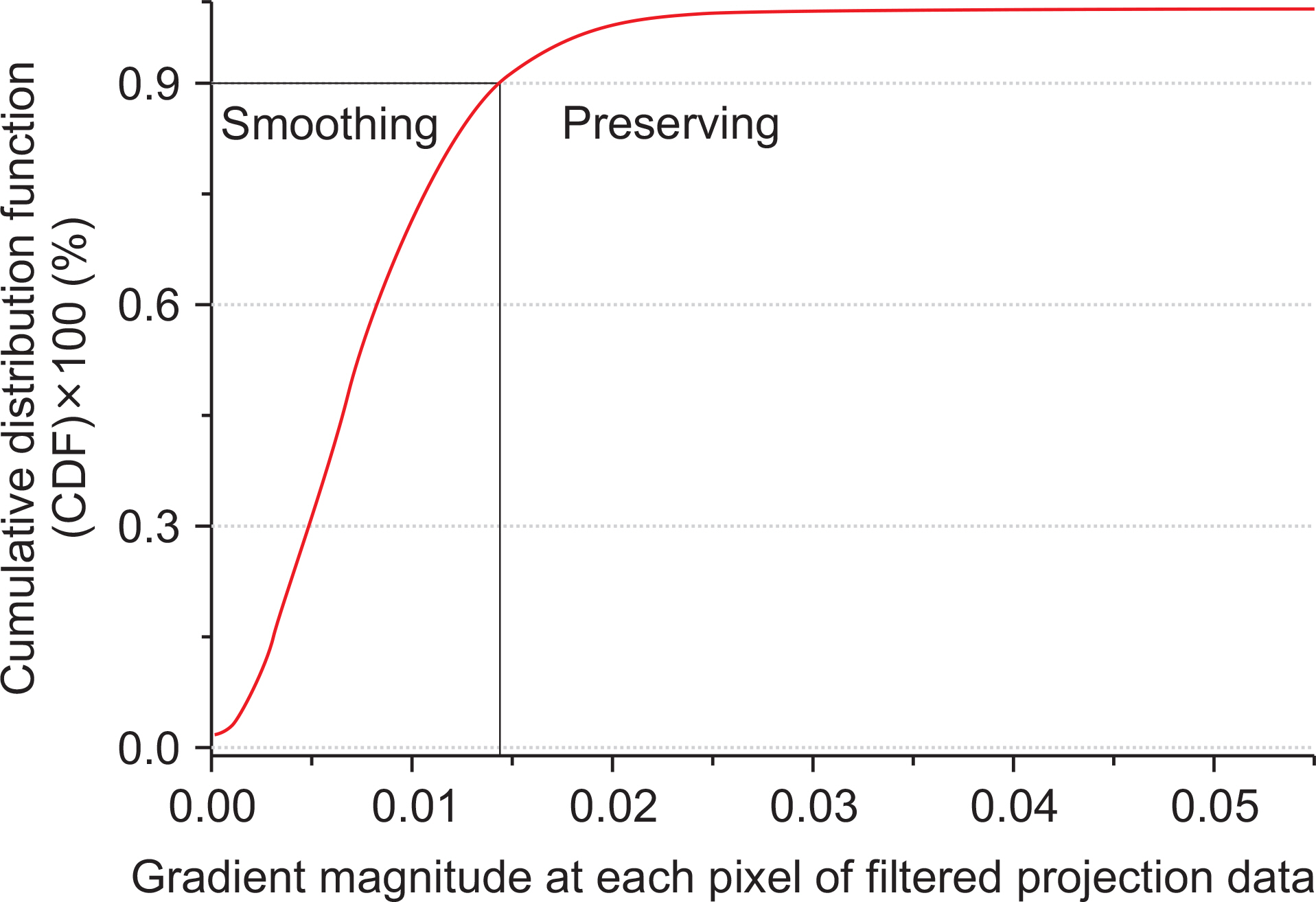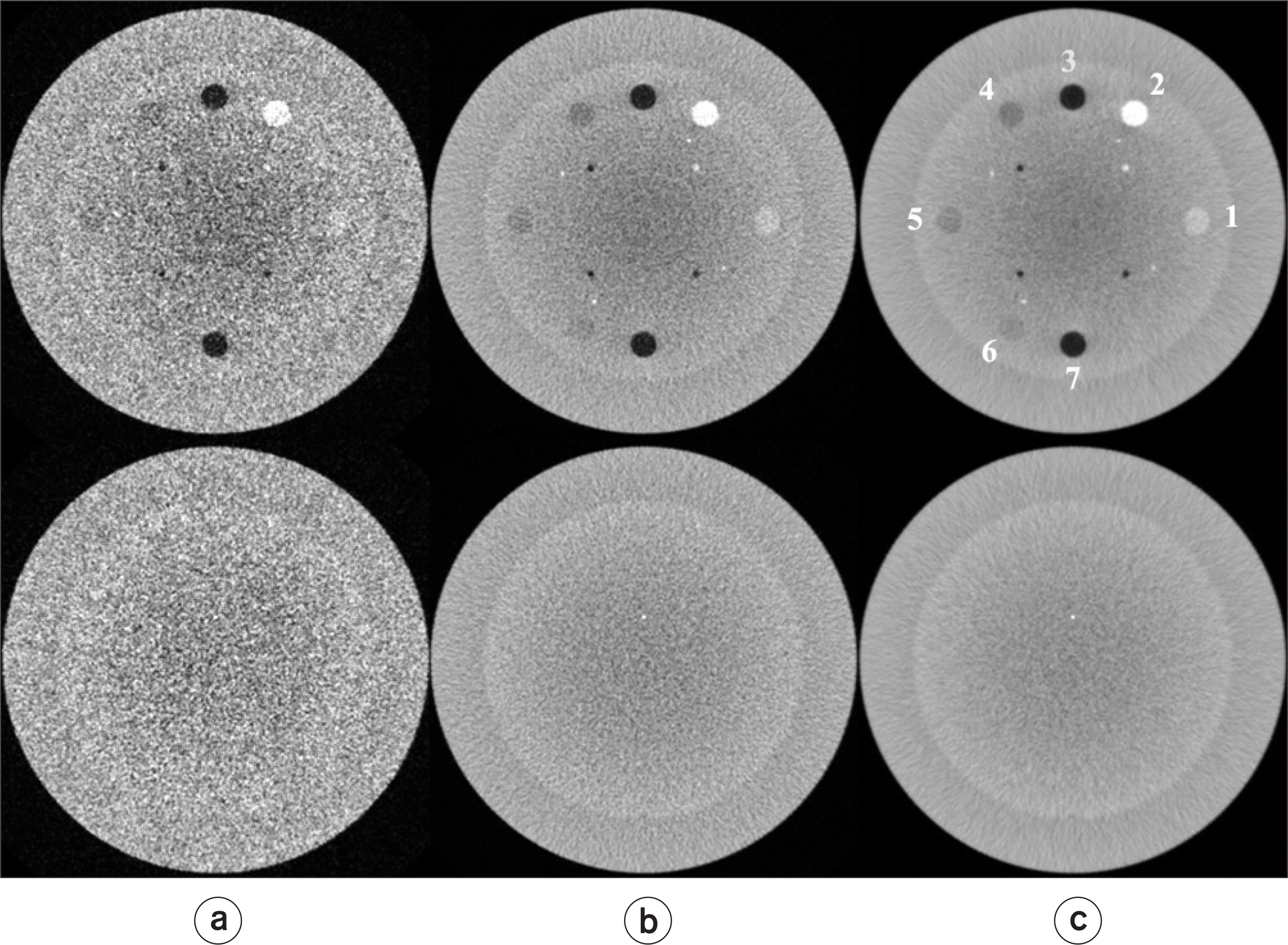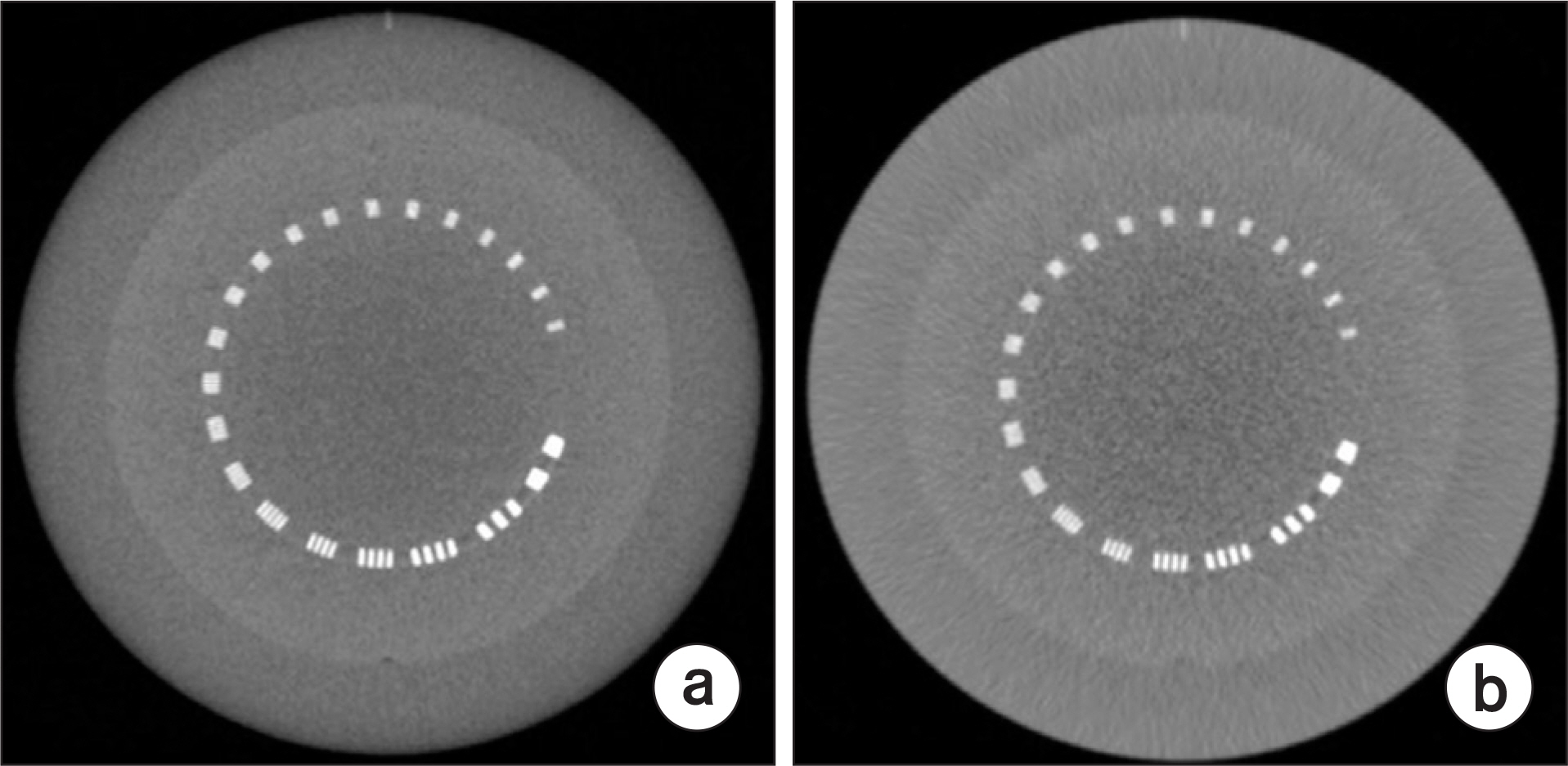Prog Med Phys.
2018 Dec;29(4):150-156. 10.14316/pmp.2018.29.4.150.
Anisotropic Total Variation Denoising Technique for Low-Dose Cone-Beam Computed Tomography Imaging
- Affiliations
-
- 1Department of Radiation Oncology, Yonsei University College of Medicine, Seoul, Korea. holee@yuhs.ac
- 2Department of Radiation Oncology, Seoul National University Hospital, Seoul, Korea.
- 3Department of Radiation Oncology, Ewha Womans University Medical Center, Seoul, Korea.
- KMID: 2434649
- DOI: http://doi.org/10.14316/pmp.2018.29.4.150
Abstract
- This study aims to develop an improved Feldkamp-Davis-Kress (FDK) reconstruction algorithm using anisotropic total variation (ATV) minimization to enhance the image quality of low-dose cone-beam computed tomography (CBCT). The algorithm first applies a filter that integrates the Shepp-Logan filter into a cosine window function on all projections for impulse noise removal. A total variation objective function with anisotropic penalty is then minimized to enhance the difference between the real structure and noise using the steepest gradient descent optimization with adaptive step sizes. The preserving parameter to adjust the separation between the noise-free and noisy areas is determined by calculating the cumulative distribution function of the gradient magnitude of the filtered image obtained by the application of the filtering operation on each projection. With these minimized ATV projections, voxel-driven backprojection is finally performed to generate the reconstructed images. The performance of the proposed algorithm was evaluated with the catphan503 phantom dataset acquired with the use of a low-dose protocol. Qualitative and quantitative analyses showed that the proposed ATV minimization provides enhanced CBCT reconstruction images compared with those generated by the conventional FDK algorithm, with a higher contrast-to-noise ratio (CNR), lower root-mean-square-error, and higher correlation. The proposed algorithm not only leads to a potential imaging dose reduction in repeated CBCT scans via lower mA levels, but also elicits high CNR values by removing noisy corrupted areas and by avoiding the heavy penalization of striking features.
Keyword
Figure
Reference
-
1.Nabavizadeh N., Elliott DA., Chen Y, et al. Image guided radiation therapy (IGRT) practice patterns and IGRT's impact on workflow and treatment planning: Results from a national survey of American Society for Radiation Oncology members. International Journal of Radiation Oncology∗ Biology∗ Physics. 2016. 94(4):850–57.
Article2.Lu L., Diaconu C., Djemil T, et al. Intra–and inter–fractional liver and lung tumor motions treated with SBRT under active breathing control. Journal of Applied Clinical Medical Physics. 2018. 19(1):39–45.3.Yoganathan S., Maria Das K., Maria Midunvaleja K, et al. Evaluating the image quality of cone beam CT acquired during rotational delivery. The British Journal of Radiology. 2015. 88(1054):20150425.
Article4.Alaei P., Spezi E. Imaging dose from cone beam computed tomography in radiation therapy. Physica Medica. 2015. 31(7):647–58.
Article5.Wang J., Li T., Liang Z., Xing L. Dose reduction for kilovotage cone-beam computed tomography in radiation therapy. Physics in Medicine and Biology. 2008. 53(11):): 2897.
Article6.Feldkamp LA., Davis LC., Kress JW. Practical cone-beam algorithm. Journal of the Optical Society of America A. 1984. 1(6):612–19.
Article7.Ahmadi R., Farahani JK., Sotudeh F., Zhaleh A., Garshasbi S. Survey of image denoising techniques. Life Science Journal. 2013. 10(1):753–55.8.Motwani MC., Gadiya MC., Motwani RC., Harris FC. Survey of image denoising techniques. Proceedings of GSPX. 2004. 27–30.9.Sidky EY., Pan X. Image reconstruction in circular conebeam computed tomography by constrained, total-variation minimization. Physics in Medicine and Biology. 2008. 53(17):4777–807.
Article10.Perona P., Malik J. Scale-space and edge detection using anisotropic diffusion. IEEE Transactions on Pattern Analysis and Machine Intelligence. 1990. 12(7):629–39.
Article11.Wang J., Li T., Xing L. Iterative image reconstruction for CBCT using edge–preserving prior. Medical Physics. 2009. 36(1):252–60.
Article12.Sidky EY., Pan X., Reiser IS., Nishikawa RM., Moore RH., Kopans DB. Enhanced imaging of microcalcifications in digital breast tomosynthesis through improved image-reconstruction algorithms. Medical Physics. 2009. 36:4920–32.
Article13.Lee H., Xing L., Davidi R., Li R., Qian J., Lee R. Improved compressed sensing-based cone-beam CT reconstruction using adaptive prior image constraints. Physics in Medicine and Biology. 2012. 57(8):2287–307.
Article14.Sun T., Sun N., Wang J., Tan S. Iterative CBCT reconstruction using Hessian penalty. Physics in Medicine and Biology. 2015. 60(5):): 1965.
Article15.Lee H., Fahimian BP., Xing L. Binary moving-blocker-based scatter correction in cone-beam computed tomography with width-truncated projections: proof of concept. Physics in Medicine and Biology. 2017. 62(6):): 2176.
Article16.Wang J., Lu H., Li T., Liang Z. Sinogram noise reduction for low-dose CT by statistics-based nonlinear filters. Medical Imaging 2005: Image Processing: International Society for Optics and Photonics. 2005. 2058–67.
Article17.Lee H., Xing L., Lee R., Fahimian BP. Scatter correction in cone-beam CT via a half beam blocker technique allowing simultaneous acquisition of scatter and image information. Medical Physics. 2012. 39(5):2386–95.
Article18.Park H-G., Shin Y-G., Lee H. A fully GPU-based ray-driven backprojector via a ray-culling scheme with voxel-level parallelization for cone-beam CT reconstruction. Technology in Cancer Research and Treatment. 2015. 14(6):709–20.
Article
- Full Text Links
- Actions
-
Cited
- CITED
-
- Close
- Share
- Similar articles
-
- Cone beam CT findings of retromolar canals: Report of cases and literature review
- Comparison of effective dose for imaging of mandible between multi-detector CT and cone-beam CT
- Three-dimensional imaging modalities in endodontics
- Patient radiation dose and protection from cone-beam computed tomography
- Accessory mental foramen: A rare anatomical variation detected by cone-beam computed tomography





